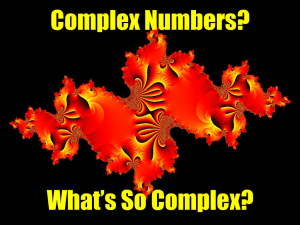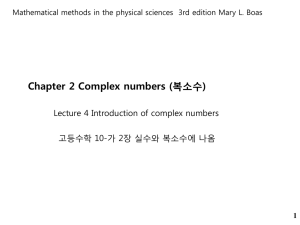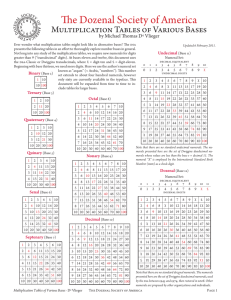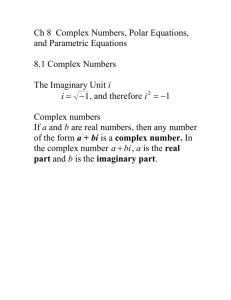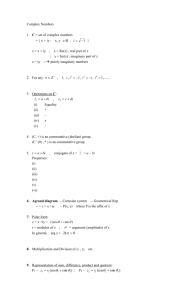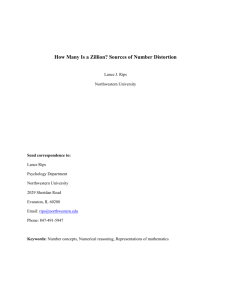biolinguistics, minimalist grammars, and the emergence of
advertisement
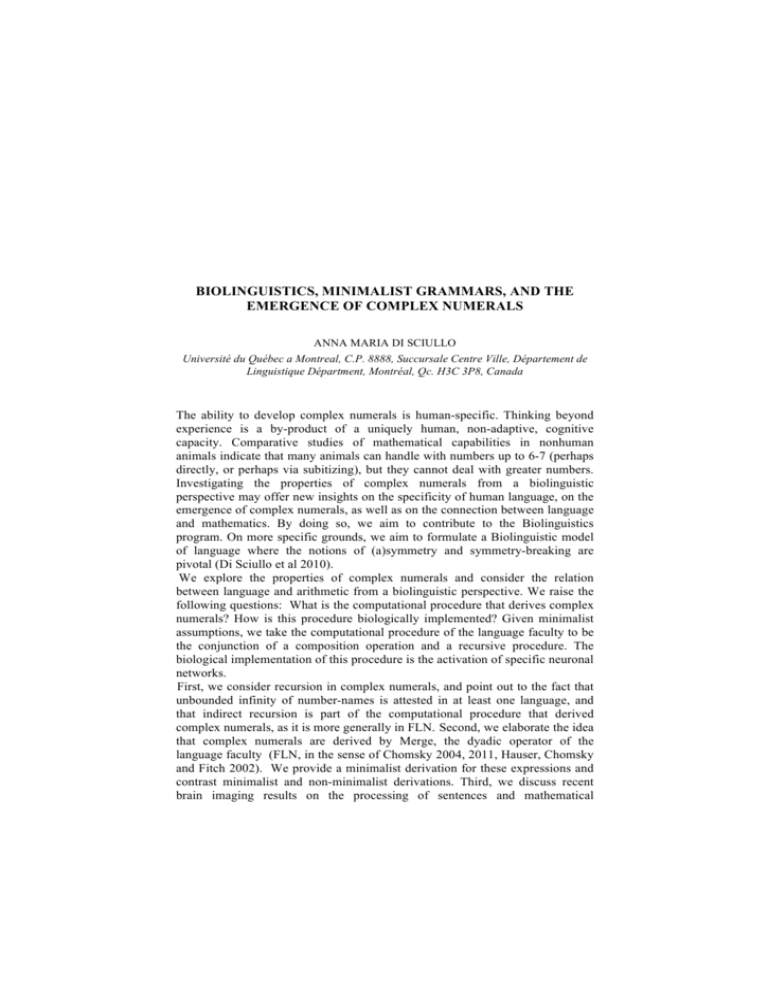
BIOLINGUISTICS, MINIMALIST GRAMMARS, AND THE EMERGENCE OF COMPLEX NUMERALS ANNA MARIA DI SCIULLO Université du Québec a Montreal, C.P. 8888, Succursale Centre Ville, Département de Linguistique Départment, Montréal, Qc. H3C 3P8, Canada The ability to develop complex numerals is human-specific. Thinking beyond experience is a by-product of a uniquely human, non-adaptive, cognitive capacity. Comparative studies of mathematical capabilities in nonhuman animals indicate that many animals can handle with numbers up to 6-7 (perhaps directly, or perhaps via subitizing), but they cannot deal with greater numbers. Investigating the properties of complex numerals from a biolinguistic perspective may offer new insights on the specificity of human language, on the emergence of complex numerals, as well as on the connection between language and mathematics. By doing so, we aim to contribute to the Biolinguistics program. On more specific grounds, we aim to formulate a Biolinguistic model of language where the notions of (a)symmetry and symmetry-breaking are pivotal (Di Sciullo et al 2010). We explore the properties of complex numerals and consider the relation between language and arithmetic from a biolinguistic perspective. We raise the following questions: What is the computational procedure that derives complex numerals? How is this procedure biologically implemented? Given minimalist assumptions, we take the computational procedure of the language faculty to be the conjunction of a composition operation and a recursive procedure. The biological implementation of this procedure is the activation of specific neuronal networks. First, we consider recursion in complex numerals, and point out to the fact that unbounded infinity of number-names is attested in at least one language, and that indirect recursion is part of the computational procedure that derived complex numerals, as it is more generally in FLN. Second, we elaborate the idea that complex numerals are derived by Merge, the dyadic operator of the language faculty (FLN, in the sense of Chomsky 2004, 2011, Hauser, Chomsky and Fitch 2002). We provide a minimalist derivation for these expressions and contrast minimalist and non-minimalist derivations. Third, we discuss recent brain imaging results on the processing of sentences and mathematical expressions and raise the question of how complex numerals are processed by the brain. We hypothesize that arithmetic is grounded in FLN, but goes beyond it. 1. Recursion We consider recursion in complex numerals in English, e.g., twenty one, one hundred and one, one thousand one hundred and twenty one, … as well as in the Romance languages vingt et un (Fr), venti e um (Port), douăzeci şi una (Ro) (twenty and one), treinta y siete (Sp) (thirty seven) cento e uno (It) (one hundred one) and provide evidence that complex numerals exhibit indirect recursion on the basis of the occurrence of functional elements, coordinating conjunctions, that may be pronounced in some cases or remain silent. Conjunctions are assumed to be asymmetric structures (Kayne 1994), under an X-bar analysis (Kayne, 1994; Munn, 1987; Johannessen, 1998) and under an adjunction analysis (Munn 1993). According to the adjunction approach, XP is a projection of the first conjunct XP and XP dominates XP. Adopting the adjunction analysis for coordination, we analyze complex nominals as adjunction structures contra Ionin & Matushansky (2006), where some complex nominals are head-complement structure. Recursion is a property of the operations of FLN (Hauser, Chomsky & Fitch 2002) gives rise to the discrete infinity of linguistic expressions. Chinese complex numerals provide empirical evidence of unbounded recursion, complex numerals in English and in the Romance languages provide evidence of indirect recursion. We conclude that the recursive procedure operative in the derivation of complex numerals shares properties with the recursive procedure of FLN. It has been argued that numerals do not present the same recursive properties than language, and that English number-names is finite (Merrifield 1968, Greenberg 1978, a.o.). However, there is al least one human language where number names show unbounded recursion (wu zhao zhao zhao zhao wu zhao zhao (Ch) (five trillion trillion trillion trillion five trillion trillion) (Brainerd 1971, Radzinski 1991). This provides empirical evidence for the discrete infinity of number-names, hypothesized for very large numbers in English (e.g. million : thousand thousand, (Amer.), billion : thousand thousand thousand, (Amer.), (Zwicky 1963). It has been shown that TAG or MCTAG could not derive Chinese number-names (Radzinski 1991). This fact, along with the constraint on the order of the terms in complex numerals, as well as legibility phenomena discussed in section 3, could be attributed to language-mathematic interface properties. 2. Merge Chomsky’s (1988) discussion of counting as an abstraction of the Faculty of Language offers two reasons for which it should be the case, i) the development of the mathematical ability in different people, and ii) the improbability of a system exhibiting discrete infinity. Merge is crucial for counting as well as for thinking about the unobservable. Assuming the simplest possible lexicon, with only one LI ‘one’, the successor function can be derived by recursive applications of External Merge (Chomsky 2008) selecting ‘one’ from the lexicon, or by Internal Merge, if a single term numeration would permit only one selection (Bolender 2011). We argue that Merge (External and Internal) is also uniquely human because the computational procedure is based on feature asymmetry. This property of Merge has not been found in the form on non-human expressions to our knowledge (Di Sciullo 2005, Di Sciullo and Isac 2008). We show that Asymmetric Merge derives complex numerals. Numerals (NUM) are related by functional projections F with valued features (ADD, MULT) and unvalued features (uNUM). The uninterpretable features are eliminated elimination, and the interpretable features are legible by the neuronal system that processes arithmetic expressions, even when the valued features are not pronounced. MULT is never pronounced e.g., three hundred, trecento (It.) ‘three hundred’, quatre mille (Fr.) ‘four thousand’, while ADD is pronounced by and /e (It)/et (Fr.) in restricted contexts, e.g., one hundred and one, cento e uno (It.), vingt et un (Fr.) ‘twenty one’. Complex numerals are derived by asymmetric merge. (Un)pronounced functional heads merge within numerals in the derivation of complex numerals, which then presents a particular case of indirect recursion. Indirect recursion introduces configurational asymmetry in a set of otherwise unstructured numeric terms. 3. Brains Brain-imaging results reported in Friedrich & Friederici (2009), Friederici et al. (2011), indicate that the brain interprets mathematic and syntactic expressions differently, as evidenced by differences in the strength of fronto-parietal activations. These imaging results bring support to our claim that complex numerals and syntactic expressions are derived by Merge and the recursive procedure of FLN, while their interpretation differ. This difference might be due to the way in which the neuronal network is activated. We show that the interpretation of the (un)pronounced heads in complex numerals differs from their interprtation in phrasal syntax. 3.1 Numeral ADD conjunctions are distinct from phrasal AND conjunctions, notwithstanding the fact that their functional heads can be pronounced by and/e/et. 3.2. Some phrasal AND conjunctions are symmetrical, numeral ADD conjunctions are asymmetrical only. 3.3. Phrasal AND conjunctions cannot be interpreted as the sum of their parts, numeral ADD conjunctions must be. 3.4. Phrasal conjunctions with an unpronounced head cannot be interpreted as the product of their parts; whereas this is the case for complex numerals with an unpronounced MULT head, e.g., les nombres deux, cent et mille (Fr.) ‘the numbers two, one hundred, and one thousand’ (2, 100, 1,000), vs. deux cent mille (Fr.) ‘two hundred thousand’ ((2 x 100) x 1,000). These facts indicate that complex numerals interface with the neuronal network sub-serving mathematics. It supports the view that complex numerals emerged with Merge and the recursive procedure of FLN, while their locus of interpretation is the interface with the neuronal network sub-serving mathematics. Acknowledgements This work is supported in part by funding from the SSHRC of Canada to the Major Collaborative Research Initiative on Interface Asymmetries 214-20031003, www.interfaceasymmetry.uqam.ca, and by a grant from the FQRSC to the Dynamic Interfaces research project grant no 103690. References Chomsky, N. (2011). Poverty of the stimulus unfinished business. To appear in A.M. Di Sciullo (ed.) Interfaces in Language Design. Chomsky, N. (2005). Three factors in language design. Linguistic Inquiry 36:122. Friedrich, R. & A.D. Friederici. (2009). Mathematical Logic in the Human Brain: Syntax. PLoS ONE 4(5): e5599. Hauser, M., Chomsky, N., & T. Fitch. (2002). The faculty of language: what is it, who has it, and how did it evolve. Science 198. 1569-79 Ionin, T. & O. Matushansky. (2006). The composition of complex cardinals. Journal of Semantics 23: 315–360. Hurford, J. R. (2003). The Interaction between Numerals and Nouns. In: F. Plank (ed.) Noun Phrase Structure in the Languages of Europe, Empirical Approaches to Language Typology. Mouton de Gruyter, pp. 561–620. 1.1. References and Citations References and citations should be in the APA style. We have included examples of reference style for various publication types in the References section. References Hauser, M. D., & Fitch, W. T. (2003). What are the uniquely human components of the language faculty? In M. H. Christiansen and S. Kirby (Eds.), Language evolution (pp. 158-181). Oxford: Oxford University Press. Pinker, S., & Bloom, P. (1990). Natural language and natural selection. Behavioral and Brain Sciences, 13, 707-784. Tomasello, M. (2003). Constructing a language: A usage-based theory of language acquisition. Cambridge, MA: Harvard University Press.
